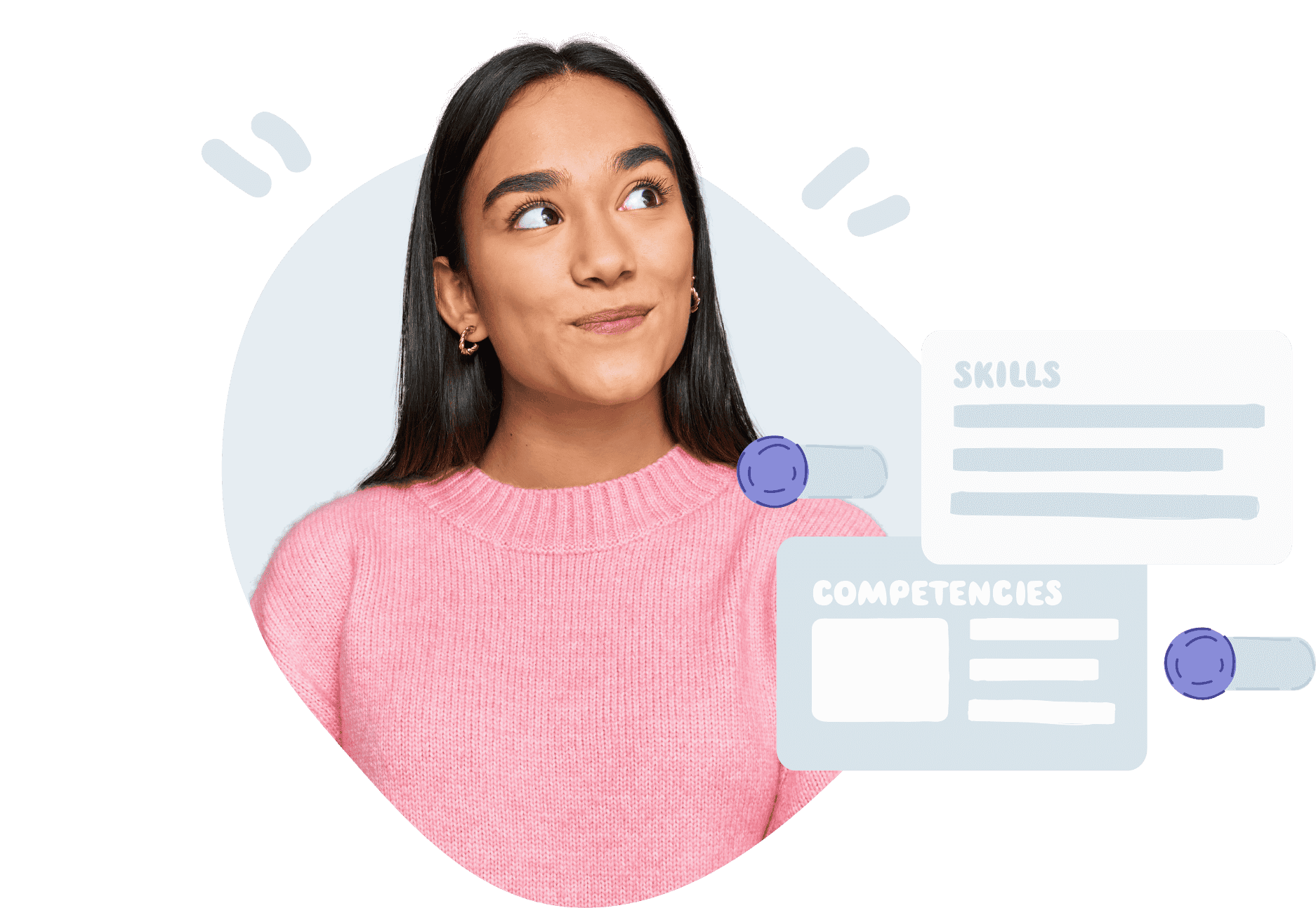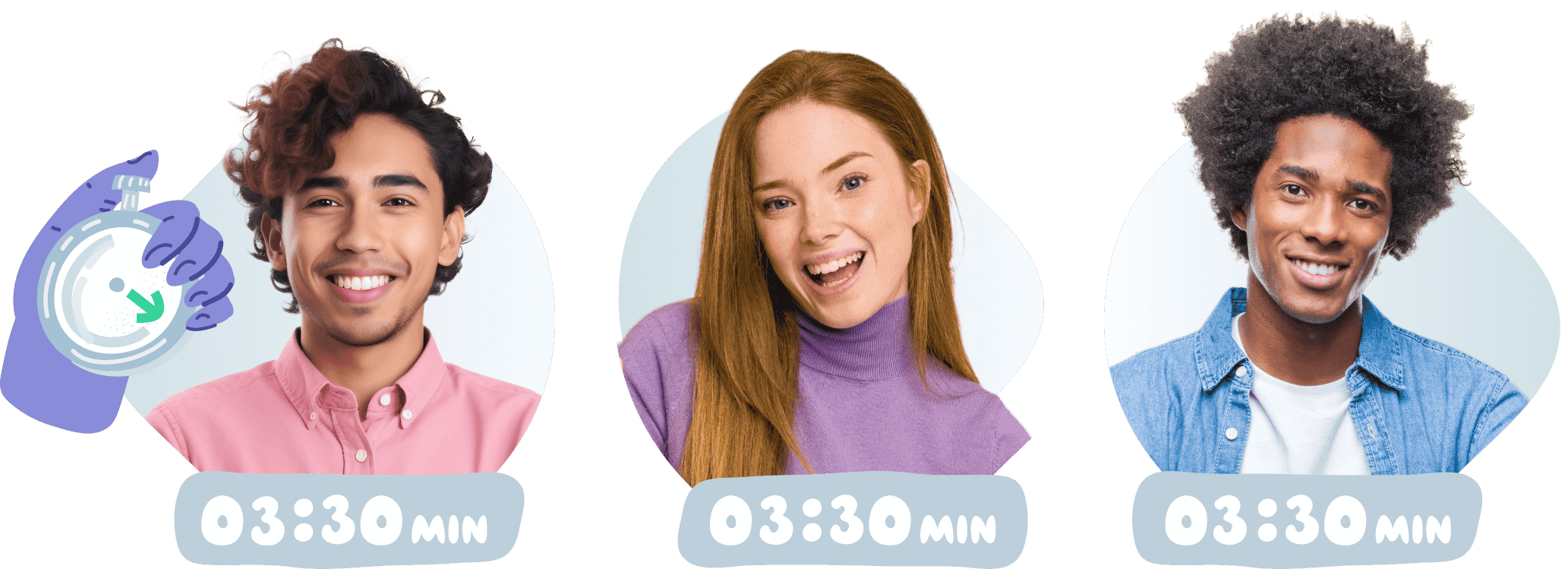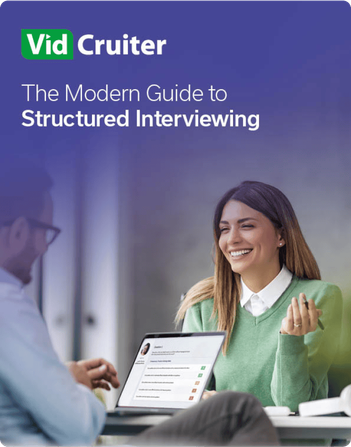
How To Schedule an Interview
What methods are HR teams using to schedule their interviews with candidates? Find best practices in this article.

TL;DR: How To Conduct a Structured Interview
Structured interviewing starts with planning the process. Each role has unique requirements and selection criteria determined by the job analysis. Once the groundwork is done, the hiring team selects the candidates, conducts the interview, and carries out post-interview activities.
The interview structure should be in place before interviewing the first candidate. Developing the structure starts with conducting a job analysis, then that information is used to select the competencies and skills to assess for, develop and refine interview questions and the associated interview scorecards, and establish a candidate selection method.
From there, the process is built. Every element is planned: the interview format and environment, the interviewers assigned to each interview stage, the interview scheduling process, how candidates are prepared, how the questions are ordered and assigned, how and when interviewers will be trained, and how everything is documented.
The interview takes place following a template outlined in the structured interview guide. The interview process is completed after rating candidate responses, completing a group evaluation (if the process calls for it), organizing interview notes and records, conducting a candidate experience audit, and providing applicants with feedback.
Learn about the benefits of structured interviewing
If you are unfamiliar with structured interview methodology, here’s an example of a structured interview process:
Ideally, the interview process is well-structured and supported with the appropriate technology to enable interview compliance and interview intelligence. Every element of the process is carefully considered, selected, and carried out in line with structured interview best practices, enabling hiring managers to make the best choices and helping candidates understand and trust they are being treated fairly.
There are many interview process steps, and the more you skip or miss steps, the less structured your hiring strategy is. It doesn’t take much for a structured process to become semi-structured or even unstructured, and for your organization to lose out on some benefits.
What is interview compliance?
Interview compliance is a framework that ensures all interviews adhere to proven methods and procedures, maximize effectiveness and fairness, and remain responsive to legal, ethical, and social values.

What is interview intelligence?
Interview intelligence uses artificial intelligence, machine learning, or powerful automation to streamline, assess, and enhance hiring processes.
Every step in the structured interview protocol serves a specific purpose. There’s a lot of planning before the job description is written to ensure the hiring and interview process is valid and consistent from beginning to end.
Every structured interview is purpose-built for the role you are hiring for. The upfront investment of time and resources that go into designing a structured interview process will pay off when you are conducting the interview.
What is a structured interview guide?
Structured interviews typically follow an interview guide that covers everything interviewers need to know about the questions, method, and process. It includes rating-specific criteria for each question so interviewers understand the evaluation ahead of the interview. Developing an interview guide is worthwhile as they’re a great way to align everyone around the process and ensure compliance.

To determine the job requirements, conduct a detailed job analysis, then decide which skills you want to assess in the interview and write the job description.
Do a comprehensive job analysis to define the responsibilities and requirements of the role. Using either a Position Analysis Questionnaire (PAQ) or the Critical Incident Technique (CIT) is recommended, as these are proven methods of collecting qualified information about the knowledge, skills, and attributes required to succeed in the role (Knowledge Solutions).
Position Analysis Questionnaire (PAQ)
Compared to many other job analysis methods, the PAQ is more effective, inexpensive, easier to learn, and simpler to use. According to the Economic Research Institute, “the user reviews background information, observes the job, and conducts thorough interviews with job incumbents to determine job content then rates the extent to which each item on a standard list of PAQ job elements applies to that particular job.”
Critical Incident Technique (CIT)
The CIT is a task analysis technique that helps you identify behaviors that contribute to success or failure in a specific job. A critical incident is when an action, or actions, contribute to an effective or an ineffective outcome. It involves gathering job incumbents or subject matter experts, recording critical incidents, grouping for similarity, sorting using a Behaviourally Anchored Rating Scale (BARS), and filling the gaps. Work incidents are often related to one of the following corporate matters: culture, knowledge, competence, relationships, beliefs, emotions, communication, or treatment. This process will require collaboration to reach a consensus when done by a group.
These two methods of conducting a job analysis can help you pinpoint which baseline competencies and skills the candidate should have when starting, and what can be learned on the job. A best practice is to rank the competencies in order of importance to job performance.
Gather all the relevant information you need to formulate appropriate interview questions. You can use performance evaluation criteria, position descriptions, task statements, and organizational charts as sources. If necessary, consult with subject matter experts, review industry standards, and consider any legal or regulatory requirements the organization and candidates must comply with.
Knowledge + Skills + Abilities = Competencies
Individually, knowledge, skills, and abilities are the “what.” They tell us what a person needs to perform a specific job. OPM says competencies specify the “how” of performing job tasks. They are the behaviors the person needs to demonstrate on the job in order to be successful.
After completing the job analysis, determine which competencies and skills you want to assess in the structured interview. In general, a structured interview evaluates between four and six. However, for leadership positions, that number may be higher.
Get all stakeholders on the same page regarding what “ideal” looks like for the role. This will clarify what the evaluation criteria should be. In addition, it will make sure all the stakeholders have the same expectations.
If you’ve done the steps above, you’ll be well prepared to write a job description. While you might think you should write the job description first, we recommend you do this after the job analysis and competency selection to make sure it accurately matches the skills and competencies you are looking for.

The next step in developing a structured interview is to create a standard set of questions. Make sure they comply with anti-discrimination and accessibility laws, in addition to being job relevant, realistic, clear, and concise. Using a standard set of questions gives all candidates an equal opportunity to provide insight into their competencies.
Open-ended questions that are informed by your job analysis are often more useful than closed-ended questions because they elicit more information from the candidate. Nevertheless, there’s a place for knockout questions, and close-ended questions that can be answered with “yes” or “no.” For example, when asking whether a candidate knows a specific coding language or can start on a certain date.
Structured interviews predominantly consist of three types of questions.
Behavioral questions
Situational questions
Competency-based questions
What did you do?
What would you do?
Walk us through your strategy for__________.
Behavioral questions are the most common type of interview question.
These questions dig into the candidate’s past actions in various situations to see if they’ve exhibited, and will continue to exhibit, the behaviors you’re looking for.
Situational questions ask how a candidate would hypothetically react to a situation in the future.
They are similar to behavioral questions, but they ask about future actions instead of past ones.
Competency-based interview questions show how a candidate uses and applies their experience and skills to a job-specific situation.
Their strengths and weaknesses come through in the answer, allowing you to see how they pair up with what’s required for the role.
Benefits
Benefits
Benefits
You can ask all behavioral-based, competency-based, or situational questions, or you can also mix question types based on insights from the job analysis.
Here’s an example of how different interview question types could come together in a structured interview:
Provide interviewers with probing questions that can be used following a candidate’s answer to get more detailed information about what the candidate thinks or feels (Indeed Career Guide). Interviewers don’t always need to ask probing questions, but if they do, they need to be from the interview guide.
Here are some sample probing questions:
Proceed with caution if you are using prompting questions in your structured interviews. According to Merit Solutions, if used incorrectly, they can provide an unfair advantage to some candidates.
Here are some sample prompting questions:
Probing vs. prompting questions
Probing questions and prompting questions often are confused. Prompting questions are commonly asked when it seems like the interviewee failed to understand the question. The questions are more pointed, making it easier for the candidate to provide the type of response the interviewer is looking for. Probing questions can be generated in advance, whereas it’s much more challenging to plan prompting questions due to their situational and reactive nature.
Gather feedback from stakeholders and experts to check that the questions you’ve created are relevant and culturally sensitive.
Stakeholders can be hiring managers, recruiters, HR professionals, and even current employees with experience in the role. Ask them to review the questions with the specific skills and competencies required for the role in mind. Request that they evaluate the clarity and relevance of the questions. In addition, invite input on any potential gaps or areas of improvement.
This feedback will enable you to refine the questions to make them more effective. For example, you may need to rephrase certain questions to make them clearer. You could also add new questions to address critical skills the initial draft missed.
Having an inclusivity expert or compliance manager review the questions to avoid including any assumptions or references to gender identity, family structure, religion, cultural notions, or other elements of identity is a diversity and inclusion recruitment best practice. They look at the phrasing, language, and wording to ensure the questions use inclusive terminology and language that applies to all job seekers.
The inclusivity expert will examine the questions to make sure they don’t inadvertently discriminate against certain groups or individuals or offend candidates. For instance, maybe you’ve written a situational question that refers to a candidate’s previous boss as “him.” The inclusivity expert might advise you to correct that to “them” to steer away from the notion that only men hold leadership positions. This feedback will help your organization fairly evaluate each candidate regardless of their background.
Evaluating and refining interview questions with stakeholder feedback is a valuable way to ensure your structured interviews are effective and inclusive. The better the questions are, the better you’ll be able to gather the information you need to make an informed hiring decision, while also demonstrating to candidates you value diversity and inclusivity in the workplace.
Once you’ve interviewed using your revised questions, if your process is digitized, you can use interview intelligence to track question performance over time and determine which questions correlate with candidate job performance.

To ensure the structured interview is effective and equitable, develop a rating and evaluation guide to go with your questions and include it in the interview guide. These predetermined criteria empower you and the other interviewers to evaluate each candidate’s responses in a uniform, objective manner. This will yield the most useful and predictive information to inform your hiring decision, according to the University of Texas.
In general, structured interviews use between a three-point and a seven-point rating scale. Here are three popular types of rating scales you could use in your interview process:
Likert scales (named after American social scientist, Rensis Likert) are a reliable way to capture nuance and measure opinions, perceptions, and behaviors (Britannica). Each number provides a detailed description of the associated competency level.
Let’s say candidates need to be evaluated on their problem-solving ability. The scale assumes everyone has the ability, but their level of competency differs. The following Likert scale may be provided to interviewers to assess a question about problem-solving:
Can problem-solve in the most difficult situations and is a resource and advisor for others
Can problem-solve in extremely difficult situations with little or no guidance
Can problem-solve in most difficult situations with minimal guidance
Can problem-solve in some difficult situations with frequent guidance
Can problem-solve but requires extensive guidance
Similar to BARS, BOS is a behavior-based measure used in relation to situational questions to evaluate performance.
For example, if you were assessing for problem-solving, you would use this five-point scale to evaluate to what degree the applicant demonstrated the desired behavior.
Almost always
Often
Sometimes
Rarely
Almost never
“Never” and “always” aren’t included as options because they’re black and white, which goes against the purpose of BOS: to capture nuance in the evaluation.
With a BARS, interviewers compare the candidate’s answers about past or future behavior against behaviors that were sorted by levels of competency in the job analysis. BARS can be used to assess almost any question type. The behavior or cluster of demonstrated behaviors that is anchored for each performance level is very specific, leaving little room for interpretation.
The result is an evaluation scale based on real experiences that clearly distinguishes between unacceptable and high-performing behaviors. This rating method works best when the job analysis is done using CIT.
Unlike the other rating scales, a BARS puts the evaluation in the context of a critical incident. Raters are evaluating to what degree the candidate would exhibit, or has exhibited, the competency in a role-specific situation.
In this example, the employer is hiring for a retail cashier and the interviewers are rating the candidate’s problem-solving abilities when serving an angry customer using this BARS.
Exceeds acceptable levels of performance (outstanding)
Listens to why they are upset. Apologizes and addresses the customer’s pain point. Remains calm regardless of what the person says or does. Continues serving the customer. Only calls the manager over if necessary.
Apologizes. Remains calm unless directly provoked. Continues serving the customer. Only calls the manager over if necessary.
Meets acceptable levels of performance (satisfactory)
Doesn’t show outward expressions of impatience. Continues serving the customer. Only calls the manager over if necessary.
Shows outward expressions of impatience. Does not apologize. Calls manager over to handle the situation.
Fails to meet acceptable levels of performance (unsatisfactory)
Shows several outward expressions of impatience. (sighs, rolls eyes, crosses arms, smirks, or laughs). Does not apologize. Talks back to the customer or takes a hostile tone. Withholds customer service.
As we’ve seen, a predefined process for evaluating the results you obtain from the interviews helps minimize personal bias and ensures consistency throughout the assessment process. Making this process digital can help with data security and privacy protection.
Based on individual assessments, you can calculate an aggregate score for each candidate to determine whether they should advance to the next hiring process step.
This stage of the assessment might require some discussion, as you’re likely to discuss each candidate’s strengths and weaknesses, as well as any discrepancies between your evaluations. If you’ve recorded the interviews on video, this is the time to review the recordings with all interviewers present to determine whether a specific score is accurate or not.

In-person interviews are no longer the only option. A 2021 LinkedIn survey found that 82% of respondents adopted virtual interviews during the pandemic. Decide if you want your structured interview process to include in-person, video, hybrid (some participants in person, some attend via video), or a mixture of these interview types.
Consider the following:
What option is most flexible or ideal for the hiring team and the candidate?
Do you have or need a user-friendly way to conduct video interviews?
Is your video conferencing/interviewing platform set up to protect candidate security and privacy?
Can it be configured to offer accessibility accommodations and work on multiple device types?
Are you hiring for a remote, in-office, or hybrid role?
How will you ensure you’re accounting for interview compliance?
Video interviews can help candidates show themselves in the best light possible, widen the candidate pool, level the playing field, and provide documentation of the interviewing process in the event of concerns or complaints.
Even within the category of interviewing software, there are two types: live video interviews and one-way video interviews. Assess your options, consider your hiring team and candidates, and make a choice that helps your organization meet its goals while empowering the people involved.
When most people think of structured interviewing, they think of keeping the list of questions, and the order, the same. While this is correct, the questions are only one element of the interview. The entire structured hiring process should be closely controlled to make deliberation fairer for every candidate, treat each candidate equally, and gather information effectively. This involves creating an interview guide with all the information and tools interviewers need to keep things consistent.
Provide guidance on the following points in the interview guide.
A hiring manager or recruiter can do the interview scheduling. Decide how scheduling will be done for each phase of interviewing in advance. The designated person can manually book the interviews, or you can use interview scheduling software to automate the booking process.
Automated scheduling tools create less manual work for employers, and enhance the candidate experience by empowering candidates to select an interview time that suits their availability and gives them instant confirmation.
Allocate time to each element of your interview workflow to ensure adequate time is blocked. Being on time can go a long way and show you value the candidate’s time. When conducting back-to-back interviews, leave a 15-minute buffer between interviews if they run long for any reason and to leave room for breaks.
As much as possible, try to keep the time of day — morning or afternoon — somewhat consistent between candidates. We recommend booking interviews on a Tuesday or Wednesday if possible. Scheduling on these days means the interviewer or interviewers has/have progressed enough into the workweek that their stamina and productivity are good to go.
Interview times matter
According to Indeed, the best time to book interviews is between 10:00 and 11:00 AM. Offering mid-morning time slots avoids the post-lunch slump and the potential for early morning meetings.
Advise interviewers to make the process as similar as possible across your organization. Whether the interview is virtual, in-person, or hybrid, it should be free of distractions to reduce the candidates’ anxiety. Put your phone on silent and close your email and messaging apps to help everyone stay focused.
Every interview should start with explaining how long the interview will take, what types of questions candidates can expect, and a disclaimer that they’ll be taking notes or typing during the conversation. If it’s a panel interview, have the panelists also introduce themselves.
Tips for creating continuity when interviewing in person
Tips for creating continuity when interviewing remotely
Tips for creating continuity when conducting hybrid interviewing

Give the interviewee plenty of notice about what type of interview they will be doing (in person, hybrid, remote), who will be there (if it’s a panel), and include the job posting so they have a clear picture of the role and the requirements. Also, let them know if you’ve allotted time for them to ask questions in the interview.
If you wrote the job description before the job analysis was completed, make sure it accurately matches the skills and competencies you are looking for so candidates can prepare accordingly. You don’t need to provide the interview questions in advance, but give enough information so the applicant can come ready with stories and examples.
Schedule interviews sufficiently far in advance to give both the interviewer and the candidate time to prepare.
A clear job description benefits you and your candidates
Job descriptions should contain the four to six skills and competencies that you will be evaluating. You can be even more direct and send candidates the list of skills and competencies in advance. If you’re doing a job simulation or assignment, inform applicants of the general topic. Many candidates appreciate any opportunity to prepare.
Consistency is the aim of structured interviewing. The same people should ask the same questions, in the same order, with the same probing questions, at each stage of the process. By keeping interviewers to the same standardized questions, you can ensure each candidate has the same opportunity to talk about their abilities and provide examples of their accomplishments.
You’ll use the interview guide for training and reference, so make it a detailed document interviewers can review before they meet with the candidates. The point is to inform them how to create a consistent environment and process for each candidate.
Test the interview you’ve designed by doing a trial run. Ask for internal feedback regarding the clarity of the questions, and evaluate whether the questions invite adequate responses. If you find the questions or the chosen environment lacking, you can address any issues before moving forward with the next step.
Documentation is a crucial part of interview compliance. Properly document each interview to minimize issues with remembering candidates’ responses and to have a record of the interview to support your hiring decision. While some organizations rely solely on the interviewers taking notes, it’s easier, smarter, and more convenient to capture and store everything digitally. Typing notes is recommended as long as you have a system for easy retrieval and enough security to stay compliant.
You should observe and document what the candidate says and your reasoning for providing a specific rating to a response.
For remote interviewing recording the interview is simple with the right video platform, but even if you’re doing a hybrid or in-person interview, you should still record it just in case. Don’t forget to get the candidates’ consent to take a video of the interview.
Live or remote, the easiest and more accurate way is to fill out a digital rating guide as you are doing the interview. That way, all the data from your evaluation is captured immediately, and if you have recruiting software, the candidates’ profile gets automatically updated.
Regardless if your interviews are in person or over video, all interviewers should take notes to summarize the content and delivery of the candidates’ answers. Note-taking is often a two-step process: ask and listen to collect data from the interview, then rate the answers independently during the interview.
Notes can shape hiring decisions, so it is especially important while the interview is happening live that the interviewers learn to avoid capturing inferences or judgments in their notes. Every question is unique but try only to capture what they describe, when what they are describing took place, what they did, or would do, and the results.
As a best practice, don’t write anything you wouldn’t want discovered in your interview notes. Also, be careful about including any details about non-verbal factors in your notes (i.e., comments about what the interviewee did, what they were wearing, etc.) because many of those indicators can introduce bias into the decision-making process.

To maximize the usefulness of interview notes, they should be:
What happens in a structured interview? While the details of structured interview processes differ depending on the role you’re hiring for, the sequence of things that occur during a structured interview shouldn’t change.
Here’s an overview of what happens in a structured interview workflow:
Interviewers should review the interview guide 15 minutes before applicants arrive to get prepared.
For panel interviews, consider having one interview board member greet and brief the applicant outside the interview room. The applicant then has an opportunity to ask any questions in a more relaxed and private setting.
For in-person interviews, arrange a separate waiting area for candidates you haven’t spoken with yet. Try to have candidates who just finished their interview exit in another direction to prevent them from interacting with the candidates waiting to interview.
Bring your remote candidate into the waiting room for hybrid or remote video interviews and let them into the interview room once everyone is ready. If you are doing a panel interview and one of your interviewers is remote, connect with them and set up their video feed before the candidate enters the interview room.
Interviews can be stressful for applicants. Start the discussion in a friendly manner to help the candidate get comfortable.
Things to cover before the structured interview begins:
It might help to write out an interview checklist so you don’t forget anything. After repeating the process a few times, it will get easier to remember.
Ask each applicant the interview questions in the same order, and the same way
If you plan on asking more than one question per competency, group the questions so you can thoroughly assess for that behavior or skill before moving on. In a panel interview, the best practice would be to have a panelist ask all the questions related to a specific competency.
Often behavior-based questions take longer to answer, so keep that in mind when scheduling. Some applicants may spend considerable time answering each question or providing irrelevant information. Train interviewers on different ways to get the interview back on track so they can maintain the interview cadence and schedule.
In addition to being mindful of how much the applicant is talking, monitoring interviewer talk times can prevent a single person from dominating the conversation. The aim is to strike a balance between the interviewer and the interviewee talking. If your interviews are conducted using hiring software, some have interview intelligence that can provide data points showing how much individual interviewers speak.
Optimize answer time for efficient interviews
Give applicants a set amount of time per question, Indeed recommends between 30 seconds and four minutes, depending on how challenging or complex the question is.

Breaks are rare but they may be necessary for longer interviews or larger panel interviews. As a best practice, if the interview is 90 minutes or longer, we recommend offering candidates an opportunity for a break partway through. Be sure to let them know how long they have or when they need to be back to keep things on track.
Try your best to answer any questions the candidate has for you while staying on schedule. Keep your answers professional, and don’t be afraid to admit if you’re unsure — you can always follow up and address their question offline.
The conclusion of the interview is a critical moment that can impact the candidate’s perception of the company and the likelihood they’ll accept a job offer. At the end of the candidate question period, thank them for participating in the interview, outline the next steps and say goodbye.
A streamlined post-interview process helps make sure the candidate feels informed and valued. It’s best practice to communicate with the candidate within 48 hours of the interview, even if you haven’t decided or don’t have any new information yet. Use it as an opportunity to reiterate what the next steps are. If you have a recruiting system, the follow-up email can be automated to reduce manual labor.
Regardless of the outcome, close the loop with each candidate. Providing closure improves the candidate’s experience and shows you are a considerate employer. In some cases, a candidate may request feedback. If this occurs, refer to your documentation and provide thoughtful observations.
Always aim to create an outstanding candidate experience and make a positive impression on the applicant—even if you don’t ultimately select them for the job.
The value of a great candidate experience
Eight out of 10 unhappy candidates will tell at least one person about a bad recruitment experience. Candidate experience is one of the many reasons why it’s worthwhile for interviewers to take extra care to open, close, and conduct interviews properly.

The job analysis will determine what competencies and skills you’re evaluating for, how many interviews you need, what type of interviews they are, and in what order. The last element of this is planning who will be interviewing the candidates. Having a diverse range of interviewers is important at every stage of the structured interview process.
Before doing anything else, check your corporate policies to see if they outline who should be present for specific interviews, and confirm who has the capacity to assist with the employee hiring process.
Make sure each interviewer possesses the ability to maintain confidentiality and evaluate candidates objectively. They need good communication skills so they can easily participate in discussions about ratings.
From there, consider the following factors when selecting interviewers:
Interviewers should be diverse in terms of gender, race, ethnicity, cognitive diversity (thinking style), and age. Incorporating a panel interview step in your structured interview process can help mitigate the opportunity for hiring biases, which in turn results in a more comprehensive evaluation of candidates. Diverse panels also help candidates feel more at ease, and demonstrate that the employer values diversity.
Tracking your panels over time can ensure you consider every facet of diversity when putting together panels. It also prevents you from using the same panel to hire everyone at the company, which is not recommended.
When selecting interviewers for a panel interview, at least one interviewer should have a thorough understanding of the knowledge, skills, and qualities a candidate needs to be successful in the position.
Last but certainly not least, ensure you have the same interview panel for all candidates interviewing for the same role. The panelists need to be available to interview all the candidates in the panel interview stage of the employee hiring process. That way, you achieve more consistency in candidate assessments.
One of the most important aspects of a structured interview is that it allows interviewers to objectively assess a candidate’s responses. To ensure objectivity, it’s critical for interviewers to complete their evaluations during the interview. If interviewers postpone filling out the rating steps or fields until the end of the interview, they might not recall someone’s response correctly, which can have a negative impact on the interview process.
You can effectively assess a candidate’s responses during an interview by following these steps:
Take detailed notes of the candidate’s response. Write down observations about what they say, and relevant non-verbal factors like body language.
Review the notes. Make sure you’ve captured all relevant information. If you believe you’ve missed something, go back and include it.
Apply the rating scale. Use the rating system you already made to assign a score to the candidate’s response.
Combine all the scores. After you’ve evaluated all the candidate’s answers, consolidate the scores for the different questions to get an overall rating.
Check for common forms of unconscious bias and errors. This is where it can be extremely helpful to have a video recording of the interview.
With one member of the hiring team chairing the discussion, bring your interviewers together after they’ve completed their ratings. Reaching consensus as a group has been found to be more valid than other methods, according to the Government of Canada’s structured interview guide. This is because coming together in a group requires interviewers to explain their ratings to their peers, resulting in more accurate evaluations.
During the meeting, interviewers can discuss their individual assessments of each competency and deliberate on a group evaluation for the applicant until a consensus is reached.
The lead interviewer should ensure that the final consensus evaluation is recorded. The rationale for the evaluation is also recorded, which would include examples of the competencies that the applicant demonstrated and the scope and depth to which they were demonstrated. After reaching a consensus on the first competency, the group can assess the remaining competencies until they are all complete.
After the group has reached a final consensus regarding each candidate’s evaluation, the lead interviewer will compile the results into a summary report that will be used as a foundation to make an informed hiring decision.

Make sure you keep sufficient notes and records during the interview itself, and also during the panel discussion of the candidates’ ratings. Typing notes is the most ideal way to take notes because they can be easily saved, secured, and retrieved.
To ensure accuracy all the way through the evaluation process, interviewers should only capture notes about how the candidate answers the questions and information that is directly relevant to the competencies discovered and shortlisted from the job analysis. Taking notes on any other criteria may introduce the opportunity for bias to impact decision-making.
In addition to interview notes, the United States Office of Personnel Management recommends keeping the following information about each interview:
An Applicant Tracking System can help tremendously with record keeping for compliance as it automatically captures all this information.
How long should you keep candidate records?
The University of Washington recommends retaining candidate records that were created and used during the hiring process, including those for the hired individual, for a period of three years after the end of the recruitment.

Gathering feedback from interviewees to evaluate their experience is key. Doing audits can help quantify and track candidate experience, offering valuable insights into the interview process. An article by SHRM says employers should “assess each stage of the process from the point of view of the job seeker, with the aim of improving those touch points to leave a positive impression.”
Ask candidates to complete a survey immediately after the interview. Include four to five questions you’ve designed to elicit specific feedback about their interview and how they found the process.
For example, you could ask questions that focus on the appropriateness of the interview setting or how easy it was to use video interview technology. You should also ask how well the interviewer communicated during the interview and if they felt they had sufficient time to answer all the questions.
Include a disclaimer letting applicants know their feedback will be used to improve candidate experience and assure them that the survey is anonymous and not tied to the job opportunity. They should feel free to provide candid feedback without worrying it will impact their chances of getting the job.
How a negative candidate experience can hit your bottom line
Most recruiters would agree candidate experience is important, but if you’re not monitoring it in some way, it’s impossible to know how it’s impacting your brand or bottom line.
In 2017, Virgin Media determined that 18% of their rejected applicants were also customers, and 6% of those discontinued their service and took their business elsewhere after having a negative recruitment interaction. The company realized they were losing $5.4 million in revenue due to poor candidate experience. As a result, Virgin Media implemented a “gold standard” interview program to turn things around.
In some cases, candidates may request feedback. Depending on your company’s policies, the feedback you share with the candidate could include the following:
Always check your organization’s policies around sharing information with candidates before you say or send anything to them. The way candidates receive feedback should be uniform for all candidates. For example, they might receive a debrief over the phone or over email.
If you are reusing the interview questions, don’t share the specifics of the interview questions, the applicant’s responses to the questions, or the assessment of their responses to the questions. If you are not reusing the questions, you can share them, but hold off until all the interviews are complete.
Prepare precision feedback
With structured interviews, the main thing to watch out for when giving feedback is sharing any information that could be considered proprietary, as this could impact the validity of the results if it was shared online or with other applicants.
Structured interviews are a standardized hiring tool characterized by three main attributes:
Structured interviewing is an integral part of interview compliance, which ensures all interviews adhere to proven methods and procedures, maximize effectiveness and fairness, and remain responsive to legal, ethical, and social values. When designing a structured interviewing process, the hiring team should ensure your organization’s Diversity, Equity, and Inclusion policy, and any other internal policies, are built into the process.
Structured interviewing can support your strategy by mitigating the influence of bias on the recruitment process, increasing the visibility of qualified candidates, and promoting adherence to all company policies.
A board interview is another term for a panel interview, which is when two or more people interview a single job candidate simultaneously. Board interviews can also be structured. Learn how to plan and execute a structured panel interview.
The nature of an assessment interview changes depending on the industry you work in and the role you’re applying for. Generally speaking, an assessment interview is used to evaluate specific knowledge, skills, abilities, and competencies before advancing a candidate to the next stage of the recruitment process. Assessment interviews can be structured or unstructured, but in order to stay in line with best practices in interviewing, structured is best.
There are many reasons to implement structured interviewing, but the most common purpose is to support inclusive hiring practices by standardizing and equalizing the recruiting process. Structured interviewing contains successful interview techniques that help employers improve candidate experience, mitigate opportunities for unconscious bias, and increase predictive validity and employee retention.

E-BOOK
The Modern Guide to Structured Interviewing
Get your free copy of VidCruiter’s comprehensive white paper about structured interviewing. This practical guide:
By providing email address, you agree to receive
updates from VidCruiter.
Read our
Privacy Policy
Modernize your hiring process with expert insights and advice.